The future, my friends, is yellow. Or at least according to Pantone, it’s yellow.
You may have never heard of the Pantone Colour Institute, the hugely influential company whose much-anticipated annual predictions for future design trends include singling the colour or colours that will somehow define any particular year. You probably don’t care in the slightest that of the two colours it’s selected for 2021, one is called Pantone 13-0647 Illuminating, a shade of eye-poppingly vibrant lemon-yellow (or Pandemic yellow as a friend wryly calls it) that the company describes as “one of strength and positivity . . . sunny and friendly”.
Amazing as it may seem, when Pantone speaks, a great many of the world’s designers and product developers listen. The result is that we can expect to see a whole lot of canary-yellow popping up everywhere in the months ahead, from fashion and home furnishings to product packaging and logos. Even, gulp! in our gardens.
So for all the yellow-phobics out there sitting on the colour fence (I count myself among you), this column is for you. For us, the future is yellow. Let’s try and embrace it, by which I don’t mean that you rip out all your borders and start afresh. A little yellow, after all, goes a long way. But all of the following late summer/autumn flowering perennials are supremely garden-worthy varieties that can be used to introduce brilliant pops of yellow into the garden or allotment. Team them with plants, with flowers and/or lush foliage in soft shades of lime-green, white, blue and grey to soften down those zingy hues. Or go full hog and partner them with plants, with flowers and foliage (gulp! again) in shades of scarlet, bronze and orange. The choice is yours . . .
1. Achillea Moonshine: Commonly known as yarrow, this long-flowering, low-maintenance, drought-tolerant, pollinator-friendly, hardy perennial produces its distinctive flat-topped umbels of lemon-yellow blooms throughout the summer months. Reaching an average height and spread of 60cm, it's perfect for a sunny, free-draining spot in a border or a gravel garden and looks great combined with ornamental grasses and silver foliage plants. It also does well in a pot or container while its long-lasting flowers are also suitable for drying.
2. Rudbeckia Goldsturm
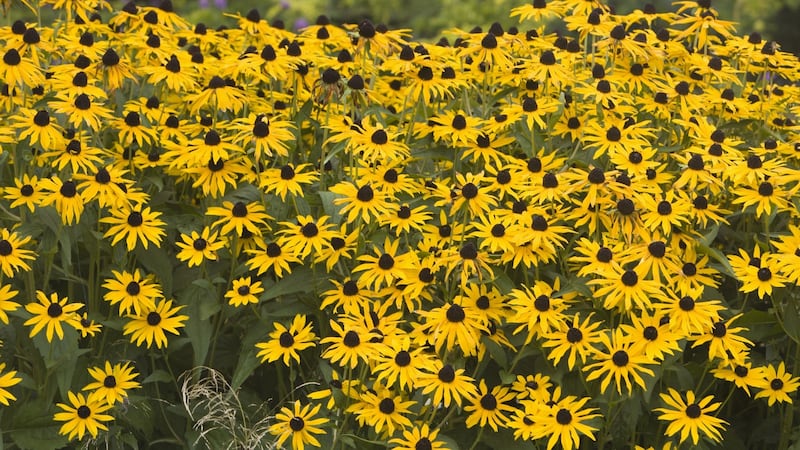
Often known as black-eyed Susan, this variety is prized for its jaunty, bright yellow, daisy-like flowers, each with that distinctive dark-brown button-like centre that earned the genus its common name. An award-winning perennial that reaches an average height and spread of 75cm x 45cm , this resilient, easy-going, very long-flowering, compact bushy plant is easy to propagate from seed while its pollinator-friendly blooms appear from late summer into late autumn. Another one of those ultra-versatile plants that looks great in a border, a gravel garden or pot, give it a sunny spot and a reasonably fertile, free-draining soil in full sun. For something much taller, seek out its lofty, lovely cousin, Rudbeckia laciniata Herbstonne (2m x 90cm).
3.Verbascum bombyciferum
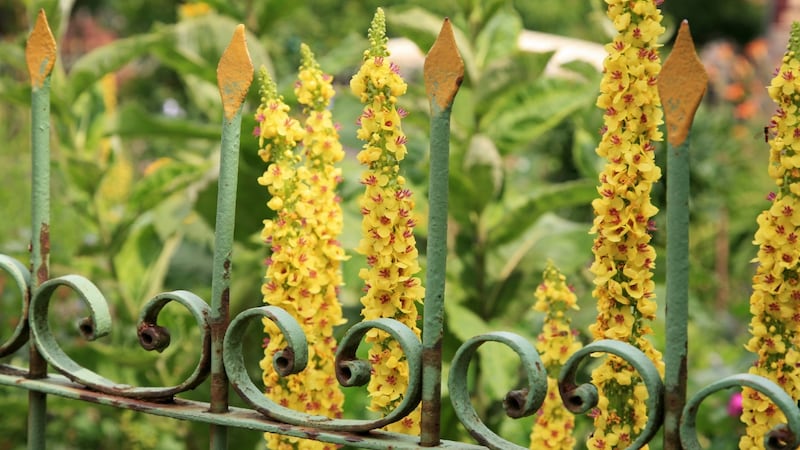
Commonly known as the mullein plant, this sun-loving, hardy, short-lived perennial has tall candles of lemon-yellow flowers that emerge from statuesque rosettes of giant, felty-grey, evergreen leaves in summer. Yet another great statement plant for a gravel garden, a coastal garden or for cottage garden-style planting, it will obligingly self-seed itself around with a preference for any free-draining nooks and crannies in the garden. Even after the flowers have faded, it retains its silhouette well into winter. Mullein is drought tolerant, but needs a light, free-draining soil in full sun to flourish and is naturally a short-lived perennial but is propagated easily from seed. Expect an average height and spread of 180 x 60cm.
4. Coreopsis verticillata, Moonbeam
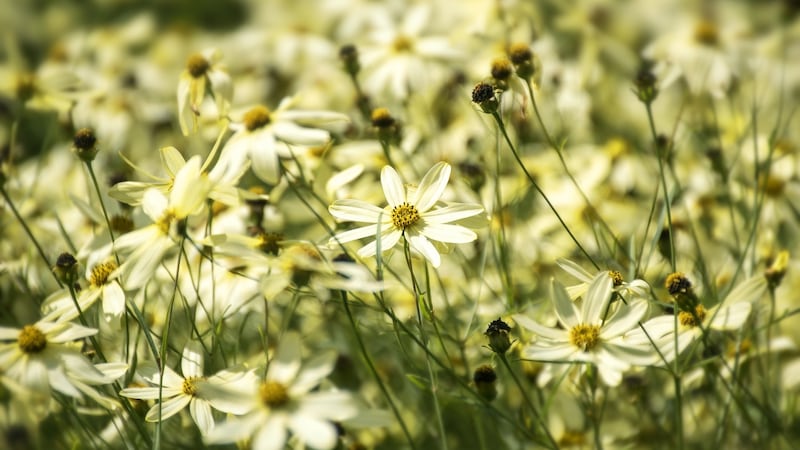
For those who don’t want to go the full yellow, Coreopsis Moonbeam is a great choice with lots of pretty, creamy-yellow, daisy-like, pollinator-friendly flowers from early summer into September. Like so many plants that are members of the daisy family, this hardy herbaceous perennial tickseed loves a moisture-retentive but free-draining soil and a warm spot in full sun but will tolerate light shade. Make sure to deadhead it regularly to keep it pumping out those pretty flowers and keep it well watered during very hot, dry spells. A compact, clump-forming variety (it reaches an average height and spread of just 50cm), it’s a good choice for the front of a sunny border or for a pot.
5. Crocosmia, George Davison

While many named varieties of crocosmia have flowers in shades of scarlet-red and rusty-orange, this one has elegant apricot-yellow flower spikes that rise from clumps of grassy foliage in July-August. A great choice for a hot border, this clump-forming bulbous perennial likes a rich, moist but well-drained soil in full sun or light shade and makes a useful, fast-growing ground-cover plant. More compact than sprawling varieties such as the scarlet-flowered Lucifer, Crocosmia George Davison reaches an average height and spread of 60cm-75cm.
6. Phlomis russeliana
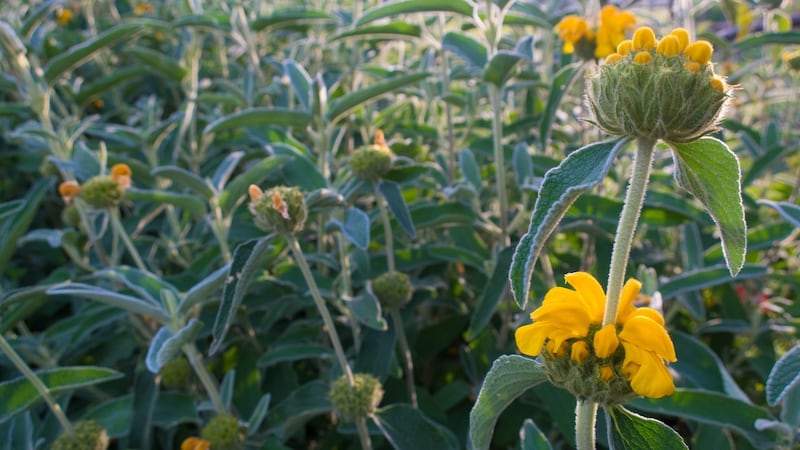
Commonly known as Turkish sage, its large, grey-green, heart-shaped leaves and elegant, statuesque yellow flower spikes belie the fact that this is a really toughie of a perennial, capable of withstanding drought and providing valuable ground cover in tough, dry spots. In bloom from May-September, its decorative seed heads also last well into the winter, making it one of those underrated workhorses of the garden. Height and spread of 80-90cm.
7. Euphorbia donni
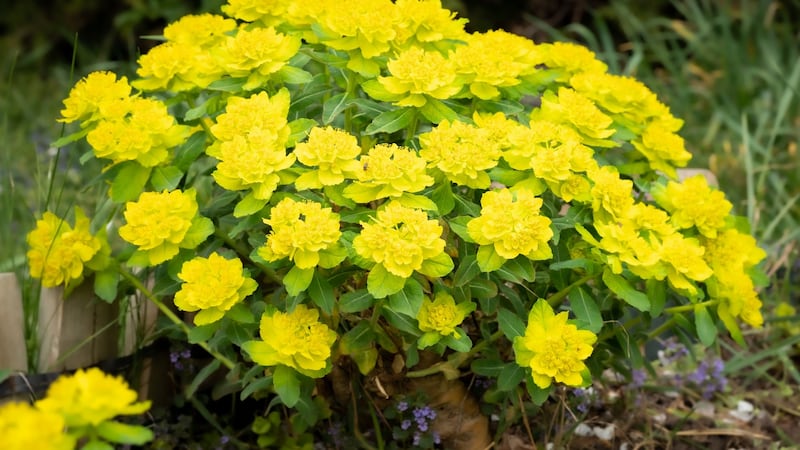
Spurges are also the unsung workhorses of many gardens, not only for the year-round structure that their handsome foliage often gives to planting schemes but also for their decorative lime-green-yellow flowers that sit easily with every other colour. Euphorbia donni is one such example, a hardy perennial with large heads of lime-yellow flowers that appear above imposing mounds of lush foliage from mid-summer to early autumn. In particular, seek out Euphorbia donna Amjillasa, a newish variety with especially handsome young foliage flushed with silver-pink that reaches an average height and spread of 100cm.
8. Kniphofia, Bees Lemon
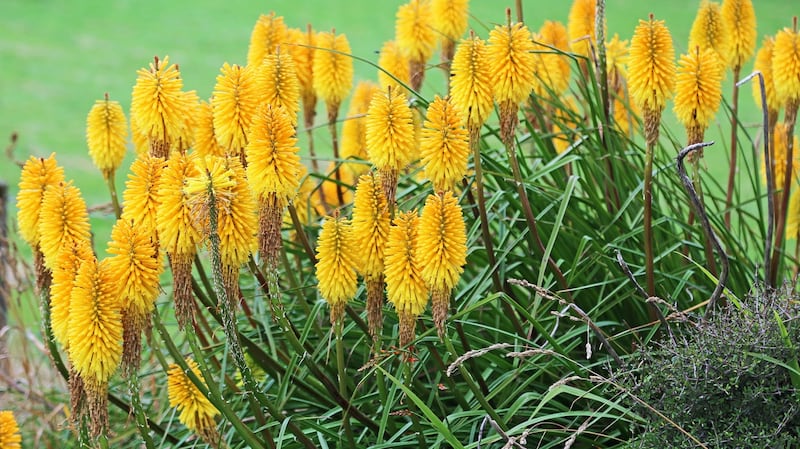
When we think of red-hot pokers, it’s typically the orange-flowering varieties that we have in mind. But the upright bottlebrush-shaped, pollinator-friendly flowers of Kniphofia Bees Lemon are a vivid shade of bright lemon, appearing on the plant from July-September. Deer resistant, rabbit resistant, fully hardy and happy in sun or light shade, this versatile herbaceous perennial likes a rich, moist but well-drained soil and reaches an average height and spread of 75cm.
9. Kirengehoma palmata

If all of the above still sounds just too yellow for your tastes, then there is one plant that even the most committed of yellow-phobes finds impossible to dislike. Called Kirengehoma palmata, this refined, clump-forming herbaceous perennial is a woodlander with elegantly toothed leaves and waxy, dangling, bell-shaped flowers of the softest lemon-yellow that appear on purple stems in August-September. Reaching an average height and spread of 120cm, it needs a rich, cool, lime-free, humus-rich, damp (but never sodden) soil and a position in the garden where its architectural foliage is sheltered from drying winds, frosts and hot sunshine. Famously slow to establish, when it does, there is no lovelier sight.
This Week in the Garden

If you sowed seed earlier this summer into pots/trays, then it’s time to prick out spring and early summer flowering biennials such as wallflowers, sweet William and honesty into individual pots or into modular trays or liners filled with a good quality compost. If you sowed the seed into a seed bed outdoors, gently thin the lines of seedlings to give them space to grow on, transplanting the thinnings into new rows. Finish by watering them generously to encourage the root systems to quickly re-establish.
Regular deadheading is really important at this time of the year to encourage plentiful production of fresh blooms and to prevent the plants from putting their energy into setting seed. Use a clean, sharp secateurs to do this, making sure to cut right back to fresh flowers, young flower buds or to just above a leaf node. Regular liquid feeds will also help to keep flowering plants healthy and productive and stop them from slowly running out of steam. Suitable liquid feeds include homemade liquid comfrey, liquid seaweed or a good quality organic liquid tomato feed, all of which are rich in potassium, the plant nutrient that boosts flower production.
Dates for your Diary:
Finishing tomorrow Sunday, August 1st, Carlow Garden Festival 2021 completes its series of talks with some of Ireland's leading garden designers, horticulturists, environmentalists and plants people. See carlowgardentrail.comor call 059-9130411 for details of events taking place this weekend which include a talk by garden designer Diarmuid Gavin and plants man Paul Smyth at the Arboretum Garden Centre in Leighlinbridge today (7.30pm) and tomorrow's guided tour of Duckett's Grove garden by the garden writer Shirley Lanigan (from 2.30pm). Prebooking recommended.










